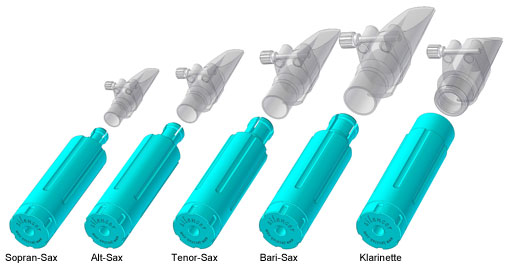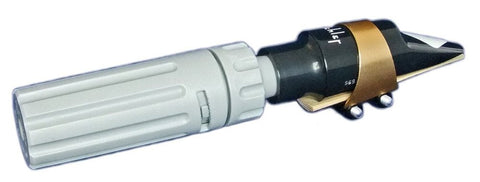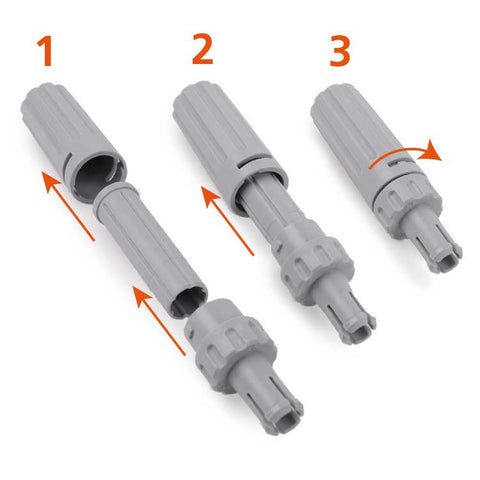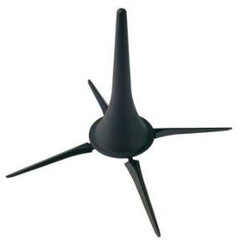- Practice anywhere at any time and the sound will be as quiet as a whisper
- Works with Soprano, Alto, Tenor, and Baritone Saxophone Mouthpieces
- Works with Clarinet Mouthpieces
- The silencer is made of high quality plastic, easy for handling and cleaning.
- Includes Book and DVD
Silencer is National Association of Music Merchants NAMM-2012 in USA award winner in the category Best Tools for Schools, selected by Panel of music educators.
___________________________________________________________________
A lot of people are often surprised when they realize that you can produce tones and whole melodies with the mouthpiece of a saxophone or a clarinet alone. What it sounds like depends solely on the person who is blowing into the mouthpiece because everything that comes out is only affected by the person who is blowing.
–
How can we understand this?
These findings prompted Joe Allard, the grand master of the woodwinds, to develop a new method of training and suitable exercises, among which are the mouthpiece exercises. With these exercises Joe Allard documented astonishing results while having comparatively little expenditure of time. Among his students were saxophonists as David Liebman, Michael Brecker, Stan Getz, Bob Berg and Glenn Miller’s whole sax-section.
–
Improving the sound continually
Mouthpiece exercises for woodwinds are one of the best methods to continually improve the sound. Furthermore, one can train the embouchure, the breathing and the articulation optimally. Daily exercises – 5 minutes are enough – are the key to a higher level of sound and intonation on the instrument. Through mouthpiece exercises you train exactly those muscles that are crucial to the playing of a saxophone or a clarinet:
- – for the sound
- – for the intonation
- – for special effects as vibrato or bending
- – for high tones
–
Music is associated to noise
Basically, one can take the mouthpiece to any place and exercise on it everywhere. For example; on the train, in a car, (only with a turned off motor of course) or in a hotel room. But practically there is one serious disadvantage: The tone produced by the mouthpiece is approximately 100 dB loud and therefore trouble with passengers or hotel guests, as well as neighbors, is already pre-programmed!
Wilhelm Busch said: “Music is often found to be disturbing because it is connected to noise.” What is loud music for one person is noise for another. Whoever wants to hear music does not feel disturbed. Whoever likes turning up the volume does this without the feeling that it is noise. The ears are a sensitive organ and what is sensed as noise depends mainly on the ability to influence the sound. Moreover, it depends on the sound, whether it sounds more or less harmonic, whether it screeches, whistles, bangs, rumbles or hammers.
«Making music is one of the basic rights of a human and can therefore not be forbidden!” This phrase stems from a judgment. Whoever plays an instrument has to practice; he has to practice even more if he is a professional musician. However, for the neighbors it is mostly more than just a disturbing sound!»
–
Avoiding conflicts
In order not to disturb the neighbors one has to become quieter. Here the silencer produces relief! With a put-on mouthpiece-mute the volume is reduced significantly: It reduces the volume by 14 to 20 decibels! In other words: The volume heard by a human is 5 to 10 times quieter. The fact is, you hear the volume a multiple quieter with the silencer. You can practice very quietly at any time – whether night or day – and at any place!
–
The silencer®
The silencer is available in five different versions:
- – for soprano sax,
- – for alto sax,
- – for tenor sax,
- – for bari sax,
- – for clarinet

The silencer for tenor saxophone for example goes with every brand of tenor saxophone mouthpieces. Unfortunately, each of these brands has its own bore. Therefore, the silencer’s coupling piece has four springy elements, which compensate for the differences among the bores and provide a tight fit at the mouthpiece. A cone at the root of the coupling piece creates the tightness. As for the clarinet, the mouthpiece-cork does the sealing while compensating, to a certain extent, for the differences in diameter.
The silencer is the result of countless hours of research and development. You are now a proud owner of a perfect mouthpiece-mute. Patents for the silencer are pending worldwide.
–
Handling and Cleaning
The silencer is comprised of three parts:
- – the housing
- – the cap
- – the insertion

The silencer is made of high quality plastic, easy for handling and cleaning. It only works correctly if all three parts are assembled correctly and are cleaned after every usage.
If you own multiple silencers for multiple instruments, please notice the fact that the coupling pieces are of different sizes. The cases are identified for the coupling pieces. (For example with “TENOR SAX” or “ALTO SAX”) Only the right insertion end fits into the cap.
The silencer’s assembly is easy: Stick the muffler with a slightly rotating movement into the mouthpiece. As for a clarinet mouthpiece, you might need some cork-grease.
After finishing the exercises you can pull the silencer – again slightly rotating – out of the mouthpiece.
Now you can easily screw off the silencer-cap and separate it from the insertion. For hygienic reasons we recommend cleaning the silencer under water after each usage. Do not use caustic cleaning agents. On demand (to decalcify it) you can put the separate parts into a glass of vinegar for one hour and then wash it with water.
After drying the parts stick the insertion into the cap and then screw the cap onto the case.
–
Now’s the time
Now you know everything that is important to start with the first mouthpiece exercises. Those are presented in silencer handbook and in a silencer video. I wish you a lot of pleasure and good proceedings while practicing them. And something else: Do not over do the practicing! Learning an instrument should always be fun and should not become an obligation. Experience by yourself how you can accomplish a great goal on the way from a saxophone player to a saxophone virtuoso through doing little steps…











